Infantry support guns or battalion guns are artillery weapons designed and used to increase the firepower of the infantry units they are intrinsic to, offering immediate tactical response to the needs of the unit's commanding officer. They typically have short, low-velocity barrels, and light construction carriages, allowing them to be more easily manoeuvered on the battlefield. They are generally used for direct fire, rather than the indirect fire of other types of artillery. Their role has generally been replaced by tanks using tank guns, infantry fighting vehicles using autocannons, other combat vehicles, mortars, recoilless rifles, rocket-propelled grenades and shoulder-launched missiles.
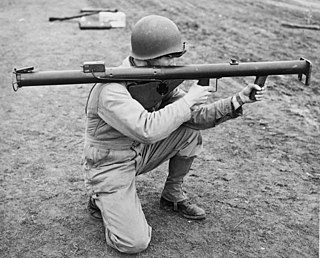
Bazooka is the common name for a man-portable recoilless anti-tank rocket launcher weapon, widely deployed by the United States Army, especially during World War II. Also referred to as the "stovepipe", the innovative bazooka was among the first generation of rocket-propelled anti-tank weapons used in infantry combat. Featuring a solid-propellant rocket for propulsion, it allowed for high-explosive anti-tank (HEAT) shaped charge warheads to be delivered against armored vehicles, machine gun nests, and fortified bunkers at ranges beyond that of a standard thrown grenade or mine. The universally applied nickname arose from the M1 variant's vague resemblance to the musical instrument called a bazooka invented and popularized by 1930s American comedian Bob Burns.

The Panzerfaust was a development family of single-shot man-portable anti-tank systems developed by Nazi Germany during World War II. The weapons were the first single-use light anti-tank weapons based on a pre-loaded disposable launch tube, a weapon configuration which is still used today.

A grenade launcher is a weapon that fires a specially designed, large-caliber projectile, often with an explosive, smoke, or gas warhead. Today, the term generally refers to a class of dedicated firearms firing unitary grenade cartridges. The most common type are man-portable, shoulder-fired weapons issued to individuals, although larger crew-served launchers are issued at higher levels of organization by military forces.
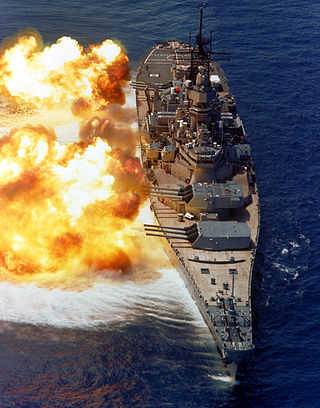
The 16"/50 caliber Mark 7 – United States Naval Gun is the main armament of the Iowa-class battleships and was the planned main armament of the cancelled Montana-class battleship.

A shell, in a military context, is a projectile whose payload contains an explosive, incendiary, or other chemical filling. Originally it was called a bombshell, but "shell" has come to be unambiguous in a military context. Modern usage sometimes includes large solid kinetic projectiles that is properly termed shot. Solid shot may contain a pyrotechnic compound if a tracer or spotting charge is used.
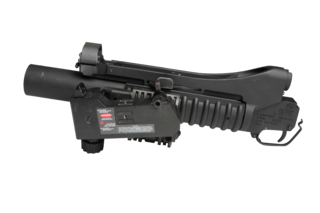
The M203 is a single-shot 40 mm under-barrel grenade launcher designed to attach to a rifle. It uses the same rounds as the older stand-alone M79 break-action grenade launcher, which utilizes the high-low propulsion system to keep recoil forces low. Quite versatile and compatible with many rifle models, the M203 was originally designed for the U.S. M16 and its carbine variant, the M4. The launcher can also be mounted onto a C7, a Canadian version of the M16 rifle; however, this requires the prior removal of the bottom handguard.
The .30-06 Springfield cartridge, 7.62×63mm in metric notation, and called the .30 Gov't '06 by Winchester, was introduced to the United States Army in 1906 and later standardized; it remained in military use until the late 1970s. The ".30" refers to the caliber of the bullet in inches. The "06" refers to the year the cartridge was adopted, 1906. It replaced the .30-03, 6mm Lee Navy, and .30-40 Krag cartridges. The .30-06 remained the U.S. Army's primary rifle and machine gun cartridge for nearly 50 years before being replaced by the 7.62×51mm NATO and 5.56×45mm NATO, both of which remain in current U.S. and NATO service. It remains a very popular sporting round, with ammunition produced by all major manufacturers.

A heavy machine gun(HMG) is significantly larger than light, medium or general-purpose machine guns. HMGs are typically too heavy to be man-portable (carried by one person) and require mounting onto a weapons platform to be operably stable or tactically mobile, have more formidable firepower, and generally require a team of personnel for operation and maintenance.

The Type 89 grenade discharger, inaccurately and colloquially known as a knee mortar by Allied forces, is a Japanese grenade launcher or light mortar that was widely used in the Pacific Theater of World War II. It got the nickname the "knee mortar" because of an erroneous Allied belief that these launchers could be fired by propping its plate against the leg. However, anyone trying to fire it this way would receive a severe bruise from its hefty recoil.
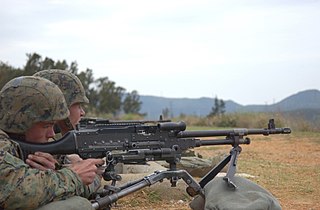
A medium machine gun (MMG), in modern terms, usually refers to a belt-fed machine gun firing a full-powered rifle cartridge, and is considered "medium" in weight. Medium machine guns are light enough to be infantry-portable, but still cumbersome enough to require a crew for optimal operational efficiency.

The Ordnance SBML two-inch mortar, or more commonly, just "two-inch mortar", was a British mortar issued to the British Army and the Commonwealth armies, that saw use during the Second World War and later.

The columbiad was a large-caliber, smoothbore, muzzle-loading cannon able to fire heavy projectiles at both high and low trajectories. This feature enabled the columbiad to fire solid shot or shell to long ranges, making it an excellent seacoast defense weapon for its day. Invented by Colonel George Bomford, United States Army, in 1811, columbiads were used in United States seacoast defense from the War of 1812 until the early years of the 20th century. Very few columbiads were used outside of the U.S. and Confederate Armies; nevertheless, the columbiad is considered by some as the inspiration for the later shell-only cannons developed by Frenchman Henri-Joseph Paixhans some 30 years later.
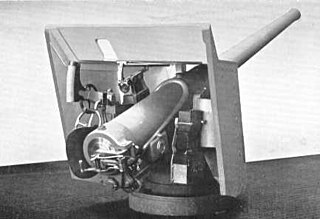
The QF 4.7-inch Gun Mks I, II, III, and IV were a family of British quick-firing 4.724-inch (120 mm) naval and coast defence guns of the late 1880s and 1890s that served with the navies of various countries. They were also mounted on various wheeled carriages to provide the British Army with a long range gun. They all had a barrel of 40 calibres length.

The 100-ton gun was a 17.72 inches (450 mm) rifled muzzle-loading (RML) gun made by Elswick Ordnance Company, the armaments division of the British manufacturing company Armstrong Whitworth, owned by William Armstrong. The 15 guns Armstrong made were used to arm two Italian battleships and, to counter these, British fortifications at Malta and Gibraltar.

The 6-inch/47 caliber Mark 16 gun was used in the main batteries of several pre-war and World War II US Navy light cruisers. They were primarily mounted in triple turrets and used against surface targets. The Mark 16DP gun was a dual purpose fitting of the Mark 16 for use against aircraft as well as surface ships. It was installed in the post-war Worcester-class light cruisers and the anti-aircraft gunnery training ship Mississippi.

The 6"/53 caliber gun formed the main battery of some United States Navy light cruisers and three US submarines built during the 1920s.
The high–low system is a design of cannon and anti-tank warfare launcher using a smaller high-pressure chamber to store propellant. It allows a much larger projectile to be launched without the heavy equipment usually needed for large caliber weapons. When the propellant is ignited, the higher pressure gases are bled out through vents at reduced pressure to a much larger low pressure chamber to push a projectile forward. The high-low system allows the weight of the weapon and its ammunition to be reduced significantly. Production cost and time are drastically lower than for standard cannon or other small-arm weapon systems firing a projectile of the same size and weight. It has a far more efficient use of the propellant, unlike earlier recoilless weapons, where most of the propellant is expended to the rear of the weapon to counter the recoil of the projectile being fired.
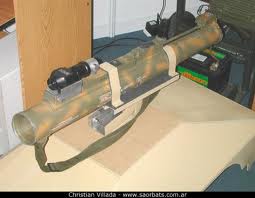
The MARA is a portable one-shot 78 mm unguided anti-tank weapon, designed and manufactured in Argentina by Fabricaciones Militares (DGFM). The solid rocket propulsion unit was developed by CITEFA.















